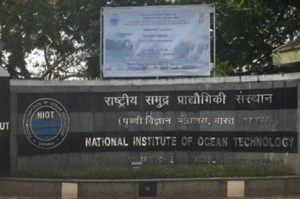Eco-friendly Crude Oil Bioremediation Mechanism Developed
NIOT scientists devise breakthrough bioremediation technique to fight oil spillage in ocean waters.
There is a grave ecological concern in the recent times due to the surge of human activity in extracting oils through offshore drilling resulting in spillage of oil either accidentally or due to negligence. Also, there are industrial effluent discharge, waste burn out and other manmade disasters polluting the marine environment. Cleaning up of the oil spillage from the oceans without damaging the marine ecosystem is becoming an increasingly challenging task due to expansion of oil exploration works in the oceanic areas. There were eight large scale oil spill disasters in different ocean areas around the globe since 1978 where an estimated 1,162 million gallons of oils were spilled into the ocean waters.
due to negligence. Also, there are industrial effluent discharge, waste burn out and other manmade disasters polluting the marine environment. Cleaning up of the oil spillage from the oceans without damaging the marine ecosystem is becoming an increasingly challenging task due to expansion of oil exploration works in the oceanic areas. There were eight large scale oil spill disasters in different ocean areas around the globe since 1978 where an estimated 1,162 million gallons of oils were spilled into the ocean waters.
Recently, the National Institute of Ocean Technology (NIOT) has successfully developed an eco-friendly crude oil bioremediation mechanism technology using consortia of marine microbes wheat bran (WB) immobilized on agro residue bacterial cells. During this study, nine different hydrocarbon-degrading bacteria extracted from the ocean sediment collected from a depth of 2100m were used. These hydrocarbon degrading bacteria don’t depend on hydrocarbon for survival but have a metabolic mechanism where they use petroleum products as carbon and energy source and thus help cleaning up oil spills. It was found that complete breakdown and degradation of crude oil was achievable using wheat bran marine bacterial consortia (which are low cost nontoxic agro-residues) immobilized on low cost nontoxic agro-residues bacterial cells in an environmentally sustainable manner. It was also found that they were more effective in their immobilized state than the free bacteria cells in degrading the oil spills, in addition to being more versatile and resistant to adverse conditions.
The NIOT study found that immobilized bacterial cells had better oil degrading capacity than the free bacterial cells. It was found that they could remove 84% of the oils within 10 days. The free bacterial cells degraded a maximum of 60% of the crude oil at optimized conditions. These findings evince their efficacy in treating accidental bulk discharge of oil in marine environment through nontoxic clean-up technology.
In marine ecosystem, hydrocarbonoclastic deep sea microbial consortium (two or more group of bacteria) plays an important role in breaking down oil in the event of a spill. The microbial community serves as energetic primary degraders of complex mixture of petroleum hydrocarbons into various aldehydes, ketones and acidic metabolites.
Petroleum is a mixture of natural gas, condensate, and crude oil (viscous liquid mixture) consisting mainly of thousands of hydrocarbon compounds.
Also Read : Phytoplankton Blooms in Southern Ocean Impact Climate Change
The present world crude oil production exceeds three billion tons a year. About half of which is transported through the sea routes and this in turn is increasing the risk of accidental oil spillage. Oil spills have the potential to cause huge environmental damage as it was observed from many of the past disasters that they end up accumulating in sub-surface sediments transferring the toxic organic materials to the marine food chain. Deepwater Horizon drilling accident was the largest accidental oil spill disaster in history that took place on April 20, 2010 releasing 779 million litres of crude oil into the Gulf of Mexico. An oil spill accident at East China Sea on January 6, 2018 released more than 136,000 tons of volatile petroleum products. The Ennore oil spill occurred outside the Kamarajar Port in Ennore near Chennai in Tamil Nadu on 28 January 2017 when an outbound empty tanker BW Maple collided with an inbound loaded oil tanker Dawn Kanchipuram releasing at 9.9 million US gallons (37,000 m3) of oils into Bay of Bengal. An oil spill accident at East China Sea on January 6, 2018 released more than 136,000 tons of volatile petroleum products.Deepwater Horizon drilling accident was the largest accidental oil spill disaster in history that took place on April 20, 2010 releasing 779 million litres of crude oil into the Gulf of Mexico. The recent MV Wakashio spill off Mauritius – About 1000 tonnes of oil spilled into a sanctuary for rare wildlife after the Japanese ship struck a coral reef on 25th July 2020. Mixtures of hydrocarbons released to the surface of marine waters are widely dispersed into different depths and end up in sediments due to oil-particle aggregation, severely affecting the local marine environment
In the present study conducted by NIOT, based on their ability to grow at variable growth conditions like pH, temperature, pressure and salinity, the hydrocarbonoclastic bacterial consortium consisting of nine deep sea bacteria with the ability to utilize crude oil as the sole source of carbon and energy with a capability to grow at variable growth conditions like pH, temperature and salinity, were characterized for crude oil degradation as well as to conduct further studyand to understand their metabolic activitypathway.
Led by G. Dharani, the research team comprised of A. Ganesh Kumar, N. Nivedha Rajan, and R. Kirubagaran of NIOT, Ministry of Earth Sciences, Government of India. The research work is published in the Journal of Marine Pollution Bulletin.
(Slider Image: The largest tanker oil spill in the East China Sea since 1991 when a tanker carrying 136,000 tons of highly flammable fuel oil crashed into a freighter on Jan 6, 2018: European Press photo Agency)
